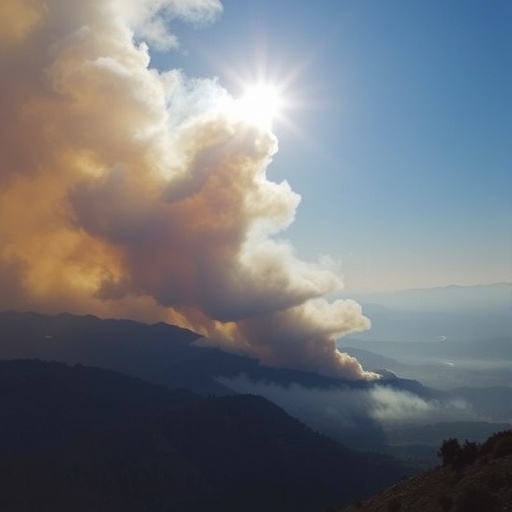Wildfires are becoming increasingly prevalent across the globe, particularly in regions prone to drought and extreme heat. A recent study conducted by researchers at the King Abdullah University of Science and Technology (KAUST) in collaboration with the Chinese Academy of Sciences sheds new light on the atmospheric implications of wildfire smoke. This research unveils the disturbing ability of smoke particles to generate hazardous oxidants, notably peroxides, when exposed to sunlight, effectively transforming these particles into reactive entities capable of complicating air quality further than previously understood.
The study argues that current atmospheric models are insufficient when it comes to predicting the sheer extent of air pollution emanating from wildfires. Traditional models fail to account for the potential of smoke particles to act as “chemical factories,” which under sunlight produce harmful compounds that not only influence smog formation but also contribute to respiratory issues among communities both near the fire and further afield. This innovative research emphasizes the urgent need for new, data-driven methodologies that more accurately reflect the complexities of wildfire emissions.
Professor Chak Chan, a key contributor to this study and the dean of KAUST’s Physical Science and Engineering Division, highlights the unique ways in which smoke particles operate in polluted environments. Typically, gases such as nitric oxide, produced from fuel combustion, inhibit the formation of oxidants through established chemical pathways. However, the findings indicate that wildfire smoke particles manage to bypass this suppression, creating oxidants internally when bathed in sunlight. The implications of this particle-driven mechanism are striking, revealing a significantly faster production of peroxides than classical models would ever account for.
Through their investigations, the research team found that organic molecules present in biomass-burning aerosols perform as “photosensitizers.” When these molecules absorb sunlight, they activate complex reaction chains that lead to the creation of highly reactive peroxy radicals, which ultimately contribute to the formation of peroxides within the smoke particles. While peroxides are not categorized as greenhouse gases, their presence in the atmosphere is troublesome as they substantially affect atmospheric chemistry, leading to phenomena such as haze, secondary particulate matter formation, and escalating respiratory health risks.
The study brings to light the pivotal role that wildfire smoke plays not only as a direct source of particulate matter—a significant element of urban air pollution—but also in contributing to the emergence of secondary particulate matter. Given that wildfires in the western United States have quadrupled in size since the 1980s, alongside a more than doubling of burn areas in the Mediterranean over the last two decades, the findings of this research acquire critical relevance. As the frequency and intensity of such fires escalate globally, the smoke they emit continually generates reactive particles, further complicated by the influence of sunlight upon them.
The consequences of these findings are profound, underscoring a significant gap in the current understanding within the scientific community regarding the dynamics of air pollution driven by wildfire smoke. Professor Chan further stresses that the overlooked chemistry revealed in their research calls for an urgent update of air quality and climate models. This would not only aid in more accurately predicting oxidant production from wildfires but also serve to equip communities worldwide—including those in Saudi Arabia—with better tools for anticipating public health risks and the broader environmental implications of a warming planet.
In an era marked by climate change and increasing fire frequency due to elevated global temperatures, the research emphasizes the importance of refining our atmospheric models. If we are to protect the health of individuals living in proximity to fire-prone areas, a more nuanced understanding of the atmospheric dynamics at play is essential. Communities need to be prepared for the ramifications that the intensified oxidant production from wildfires may present.
Moreover, the findings have the potential to inform policy changes regarding environmental protections and public health initiatives, especially in regions vulnerable to wildfire activity. As the continuing trend of catastrophic wildfires poses growing threats to air quality and public health, the research stands as a clarion call for integrating these new insights into air quality governance and climate strategies.
The urgency of revisiting atmospheric models to reflect the alarming reality of wildfire smoke contributions cannot be overstated. It is imperative that scientists and policymakers collaborate to ensure that air quality monitoring systems are equipped to handle the nuanced effects of these newly identified oxidative processes. This concerted effort will be pivotal in safeguarding not only environmental health but also the wellbeing of the increasing numbers of people affected by these changes.
In conclusion, the research unveiled by the team at KAUST and the Chinese Academy of Sciences highlights a significant development in our understanding of air pollution stemming from wildfires. The interaction between wildfire smoke and sunlight engenders a hidden layer of complexity in atmospheric chemistry that has far-reaching implications for health and climate models. As the world grapples with the escalating impact of climate change and environmental degradation, reevaluating our approaches to modeling air pollution and wildfire smoke will be crucial in fostering resilience in our communities.
Subject of Research: The effects of wildfire smoke on air pollution and oxidant production
Article Title: Fast generation of peroxides via atmospheric particulate photosensitization
News Publication Date: 1-Oct-2025
Web References: http://dx.doi.org/10.1126/sciadv.adr8776
References: N/A
Image Credits: N/A
Keywords
Air pollution, Carbon emissions, Air quality.




